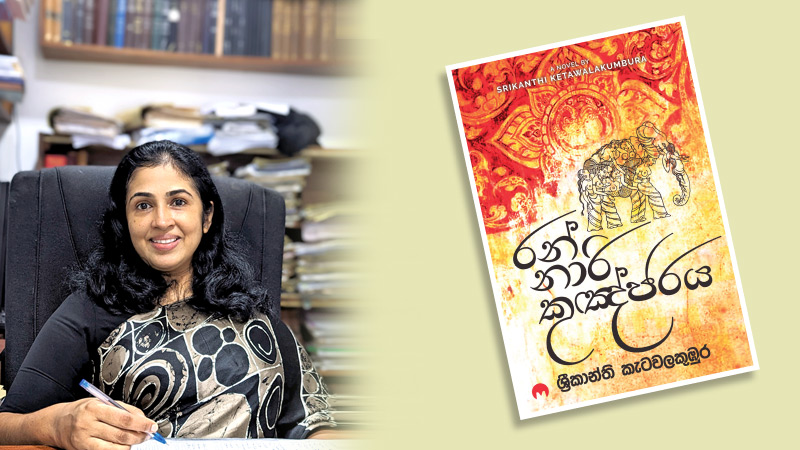Her words spring on the bosom of the earth. Her words come naturally.
 Srikanthi Ketawalakumbura, a lawyer by profession and a novelist by passion is my protagonist today. “Rannari Kunjaraya” – the second novel of Ketawalakumbura was shortlisted for this year’s “Swarna Pusthaka Award”.
Srikanthi Ketawalakumbura, a lawyer by profession and a novelist by passion is my protagonist today. “Rannari Kunjaraya” – the second novel of Ketawalakumbura was shortlisted for this year’s “Swarna Pusthaka Award”.
Set in the very outskirts of the Aluthkuru Koralaya within the boundaries of the popular Siyane Koralaya which houses Yagoda and Galahitiyawa, two relatively small villages, situated close to the Gampaha town, “Rannari Kunjaraya” runs back to the time of the British colonial administration of the then Ceylon; the story brings out a factual analysis on the social transformation that took place during the English administration, notably from 1890-1920.
The well known “Panadurawadaya” and its implications on the Buddhist renaissance is apparently a hidden conversation within the flow of the story.
The establishment of the Colombo Theosophical society by Colonel Henry Steel Olcott is also another milestone that counts a considerable significance within the setting of the novel.
The time during which the locomotive was becoming a crucial and formidable mode of transportation of goods with the island’s overall economic development had been a matter of concern, illustrated within the novel.
Helena, hails from a well-known and wealthy family with links to aristocracy is the principal character in “Rannari Kunjaraya”; the protagonist was born with a silver spoon. The lovesome and charming protagonist Helena with a winsome smile is blessed with an appealing demeanour.
Go-getter
Despite her demeanour being associated with intrinsically produced sheer sense of hubris and utter self-esteem, Helena gets attracted to Padiris whose whereabouts are not much declared. Padiris whose roots are in the city ends up at Helena’s home front where he is retained to promote the paternal business of Helena.
The go-getter in Padiris cannot wait to hitch his wagon to a star despite being his ball of fire ostensibly a bridge too far. A humorous reader may even call swarthy and dusky Padiris with gleaming teeth and a scar on the cheeks a chocolate brown skinned Ceylonese as much as Leonard Woolf commented on the island nation’s tropical complexion in his celebrated novel ‘The Village in the Jungle’.
Padiris being heavily obsessed by his rooted intention of becoming a flourishing entrepreneur declares with Helena that he is in possession of a ball made of gold that was robbed by Saradiel- the Ceylonese gang leader and bandit who became popular as “The Robin Hood of Sri- Lanka”.
While painting such a terrific heaven on earth, Padiris suggests Helena to elope with him. Meanwhile, Sedona, a domestic aid at Helena’s residence is also head over heels in love with Padiris about which Helena doubts.
Inspite of the scorn and spurn of Gimara Hamine – mother of Helena over Padiris’s fondness and penchant for her daughter, Helena is predominantly moved by Padiris’s intrinsic knack for rising to the occasion while also having an ability of taking an upper hand over her hysterical and savage brother who is notoriously known in the neighbourhood as Porisadaya.
However, the plan of action, drawn up by Helena and Padiris ends up in disarray as Padiris dies on the way to take the hand of Helena. His corpse was found lying under a bridge and that arouses the doubt of Helena that he was killed on his way to take her hand.
Helena had a different destiny. She was given in marriage to a man living in Galahitiyawa from where she begins her business that transports goods in bullock carts; her endeavour those days, notably in colonial Sri Lanka where the people were predominantly Victorian was phenomenal and unprecedented; that was exactly the time during which it was firmly believed that a woman should be confined to the household environment.
In that light ‘Ketawalakumbura’ decorates and arms her protagonist Helena as a woman whose credence and conviction are of a tremendous degree of excellence which was not heard of a woman of her community during this particular period of time.
Helena’s approach on the diversification of her business into various spectrums in the capital is the classification of her influence and ascendancy of women power over a male dominated society. The bogus myth, narrated by the late Padiris on his self-declared “golden ball” kept Helena going even afterwards she was convinced about its actuality.
Blessing in disguise
It is a classic example that reminds you of the fact that you got to look for the silver line in the dark cloud; it is a blessing in disguise. While learning the art of English speech, educating her son at prestigious schools, ultimately sending him to England on studies and indirectly influencing the locally based officers of the British Raj, the pivotal and immense difference that Helena makes at a time where women were confined to the domestic environment is of colossal significance.
Novelist Ketawalakumbura has gifted an outstanding piece of literary masterpiece to her reading community. The hallmark of Ketawalakumbura’s writing is her ability of creating a cinematic picture that dwells in the lives of her characters; her “Rannari Kunjaraya” never recedes but ever grows.
Ketawalakumbura maintains a rather candid stance even on the aspect of fiction writing; the daringness and articulation vested in her writing are of a massive authenticity; it keeps your time which is high-priced occupied.
The book is a Muses publication.









